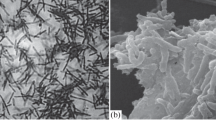Abstract
A novel, cellulolytic, bacterial thermophilic strain, T4, was isolated from sugar refinery wastewater in southern Taiwan. This isolate, a Gram-negative, motile, aerobically growing sporulating rod, can secrete thermostable endocellulase (endo-1,4-β-D-glucanase, EC 3.2.1.4) and hydrolyze carboxymethylcellulose (CMC), phosphoric acid-swollen cellulose, Avicel, filter paper, and salicin. When strain T4 was grown in CMC medium, the cellulolytic enzyme activity in culture supernatants was stable up to 70°C. More than 10% of the original activity was still detectable after heating to 100°C with a pH 7.0 for 1 h. Based on 16S rDNA sequence analysis, DNA base composition, phenotypic and physiological characteristics, as well as DNA–DNA hybridization, strain T4 was classified as Geobacillus thermoleovorans T4 (DSM 14791 = CCRC 17200). We also demonstrated that the type species G. stearothermophilus (DSM 22 = ATCC 12980) could hydrolyze amorphous and crystalline (filter paper) celluloses at a rate of 13 and 14%, respectively, in comparison with strain T4.


Similar content being viewed by others
Explore related subjects
Discover the latest articles and news from researchers in related subjects, suggested using machine learning.References
Acebal C, Castillon MP, Estrada P, Mata I, Costa E, Aguado J, Romero D, Jimenez F (1986) Enhanced cellulase production from Trichoderma reesei QM 9414 on physically treated wheat straw. Appl Microbiol Biotechnol 24:218–223
Ash C, Farrow JAE, Wallbanks S, Collins MD (1991) Phylogenetic heterogeneity of the genus Bacillus revealed by comparative analysis of small-subunit-ribosomal RNA sequences. Lett Appl Microbiol 13:202–206
Claus D, Berkeley RCW (1986) Genus Bacillus Cohn 1872. In: Sneath PHA, Mair NS, Sharpe ME, Holt JG (eds) Bergey’s manual of systematic bacteriology, vol II. Williams and Wilkins, Baltimore, pp 1105–1139
Demharter W, Hensel R (1989) Bacillus thermocloaceae, sp. nov., a new thermophilic species from sewage sludge. Syst Appl Microbiol 11:272–276
Ezaki T, Hashimoto Y, Yabuuchi E (1989) Fluorometric deoxyribonucleic acid-deoxyribonucleic acid hybridization in microdilution wells as an alternative to membrane-filter hybridization in which radioisotopes are used to determine genetic relatedness among bacterial strains. Int J Syst Bacteriol 39:224–229
Felsenstein J (1989) PHYLIP—PHYlogeny Inference Package, version 3.2. Cladistics 5:164–166
Fortina MG, Mora D, Schumann P, Parini C, Manachini PL, Stackebrandt E (2001) Reclassification of Saccharococcus caldoxylosilyticus as Geobacillus caldoxylosilyticus (Ahmad et al. 2000) comb. nov. Int J Syst Evol Microbiol 51:2063–2071
Godfrey T, Reichelt J (1983) Industrial enzymology. Nature Press, London
Heinen UJ, Heinen W (1972) Characteristics and properties of a caldoactive bacterium producing extracellular enzymes and two related strains. Arch Mikrobiol 82:1–23
Jukes TH, Cantor CR (1969) Evolution of protein molecules. In: Munro HN (ed) Mammalian protein metabolism, vol III. Academic Press, New York, pp 21–132
Kalogridou-Vassiliadou D (1992) Biochemical activities of Bacillus species isolated from flat sour evaporated milk. J Dairy Sci 75:2681–2686
Kim S-J, Chun J, Bae KS, Kim Y-C (2000) Polyphasic assignment of an aromatic-degrading Pseudomonas sp., strain DJ77, in the genus Sphingomonas as Sphingomonas chungbukensis sp. nov. Int J Syst Evol Microbiol 50:1641–1647
Logan NA, Berkeley RCW (1984) Identification of Bacillus strains using the API system. J Gen Microbiol 130:1871–1882
Mandels M, Reese ET (1957) Induction of cellulase in Trichoderma viride as influenced by carbon sources and metals. J Bacteriol 73:269–278
Markossian S, Becker P, Märkl H, Antranikian G (2000) Isolation and characterization of lipid-degrading Bacillus thermoleovorans IHI-91 from an Icelandic hot spring. Extremophiles 4:365–371
Miller GL (1959) Use of dinitrosalicylic as reagent for the determination of reducing sugars. Anal Chem 31:426–428
Nazina TN, Tourova TP, Poltaraus AB, Novikova EV, Grigoryan AA, Ivanova AE, Lysenko AM, Petrunyaka VV, Osipov GA, Belyaev SS, Ivanov MV (2001) Taxonomic study of aerobic thermophilic bacilli: descriptions of Geobacillus subterraneus gen. nov., sp. nov. and Geobacillus uzenensis sp. nov. from petroleum reservoirs and transfer of Bacillus stearothermophilus, Bacillus thermocatenulatus, Bacillus thermoleovorans, Bacillus kaustophilus, Bacillus thermoglucosidasius, and Bacillus thermodenitrificans to Geobacillus as the new combinations G. stearothermophilus, G. thermocatenulatus, G. thermoleovorans, G. kaustophilus, G. thermoglucosidasius, and G thermodenitrificans. Int J Syst Evol Microbiol 51:433–446
Priest FG, Goodfellow M, Todd C (1988) A numerical classification of the genus Bacillus. J Gen Microbiol 134:1847–1882
Sung M-H, Kim H, Bae J-W, Rhee S-K, Jeon CO, Kim K, Kim J-J, Hong S-P, Lee S-G, Yoon J-H, Park Y-H, Baek D-H (2002) Geobacillus toebii sp. nov., a novel thermophilic bacterium isolated from hay compost. Int J Syst Evol Microbiol 52:2251–2255
Sunna A, Tokajian S, Burghardt J, Rainey F, Antranikian G, Hashwa F (1997) Identification of Bacillus kaustophilus, Bacillus thermocatenulatus and Bacillus strain HSR as members of Bacillus thermoleovorans. Syst Appl Microbiol 20:232–237
Weerkamp A, Heinen W (1972) Effect of the temperature on the fatty acid composition of the extreme thermophiles B. caldolyticus and B. caldotenax. J Bacteriol 109:443–446
White D, Sharp RJ, Priest FG (1993) A polyphasic taxonomic study of thermophilic bacilli from a wide geographical area. Antonie Van Leeuwenhoek 64:357–386
Zahran HH, Moharram AM, Mohammad HA (1992) Some ecological and physiological studies on bacteria isolated from salt-affected soils of Egypt. J Basic Microbiol 32:405–413
Zarilla KA, Perry JJ (1987) Bacillus thermoleovorans, sp. nov. a species of obligately thermophilic hydrocarbon utilizing endospore-forming bacteria. Syst Appl Microbiol 9:258–264
Acknowledgements
This research was supported by a grant (NSC90-2317-B-169-001) from the National Science Council, Taiwan, ROC. We are grateful for suggestions from Dr. Hans-Jürgen Busse, University of Veterinary Medicine Vienna, Austria. We also thank Dr. Yuh-Chuahn Jang for technical support in the 16S rDNA sequence studies, Chin-Li Yen for enzymatic assays, and the Culture Collection and Research Center, Food Industry Research and Development Institute, Hsinchu, Taiwan, for determination of the fatty acids, the DNA G + C content, and the DNA–DNA hybridization.
Author information
Authors and Affiliations
Corresponding author
Additional information
Communicted by J. Wiegel
Rights and permissions
About this article
Cite this article
Tai, SK., Lin, HP.P., Kuo, J. et al. Isolation and characterization of a cellulolytic Geobacillus thermoleovorans T4 strain from sugar refinery wastewater. Extremophiles 8, 345–349 (2004). https://doi.org/10.1007/s00792-004-0395-2
Received:
Accepted:
Published:
Issue Date:
DOI: https://doi.org/10.1007/s00792-004-0395-2




